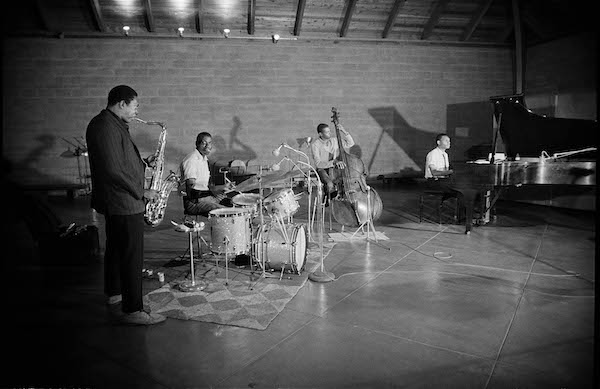Dec 9, 2025 12:28 PM
In Memoriam: Gordon Goodwin, 1954–2025
Gordon Goodwin, an award-winning saxophonist, pianist, bandleader, composer and arranger, died Dec. 8 in Los Angeles.…

On June 29, the Impulse! label will issue previously unreleased studio recordings by John Coltrane (left), Elvin Jones, Jimmy Garrison and McCoy Tyner under the title Both Directions At Once: The Lost Album.
(Photo: © Jim Marshall Photography LLC)As to why the album wasn’t released before his father’s death, Ravi said that the session may have been intentionally exploratory. “The session was recorded the very same week as the Johnny Hartman session, and the band [was about to conclude] a two-week run at Birdland. For me it did feel like, ‘OK, well, we’re doing a few sessions this week. One of them will maybe get the band warmed up, so why don’t we lay down some of the things we have been performing at Birdland all week?’ It does feel very much like a live set recorded in a studio.”
Part of that may be the amount of space these tracks give Garrison and Jones. For instance, the album-opening “Untitled Original 11383–Take 1” features a rare, driving arco solo by Garrison, while “Nature Boy” relies heavily on the way Jones’ shuffling polyrhythms contrast against Garrison’s repeated use of a syncopated anchor based on two dotted quarter notes followed by a quarter note. The two takes of “One Up One Down” both notably feature a shout chorus with Jones.
“You do get to hear the role of the rhythm section a little bit differently,” Ravi said. “There’s lots of drum solos. There’s lots of bass solos. Again, it does take on the character of a live performance.”
On a more conventional session, such as the one with Hartman, there would be less space for the rhythm section to stretch out or show off. “On those record dates, the arrangements were very, very tight, and if there were any solos at all, it was going to be a saxophone solo and a piano solo,” he added. “But on this record, you get a chance to hear the rhythm section really, really interact. Lots of great moments between Elvin and Jimmy Garrison, for sure.”
Above all, Both Directions At Once works as a snapshot of a great band on the cusp of revolution. “There are elements of the performance that do hark back to John Coltrane’s early days as a blues player and a bebop player,” Ravi said, pointing to “Vilia” and the 11-minute “Slow Blues.” But there is also material like “One Up One Down,” which, he says, “is leaning toward the music that John and the quartet eventually get to, in 1964 and ’65, playing more of these open structures. So it’s kind of a rare glimpse, to see John with one foot in the past, and one foot in the future.” DB

Goodwin was one of the most acclaimed, successful and influential jazz musicians of his generation.
Dec 9, 2025 12:28 PM
Gordon Goodwin, an award-winning saxophonist, pianist, bandleader, composer and arranger, died Dec. 8 in Los Angeles.…

Belá Fleck during an interview with Fredrika Whitfield on CNN.
Jan 13, 2026 2:09 PM
The fallout from the renaming of the John F. Kennedy Center for the Performing Arts to include President Donald…

Flea has returned to his first instrument — the trumpet — and assembled a dream band of jazz musicians to record a new album.
Dec 2, 2025 2:01 AM
After a nearly five-decade career as one of his generation’s defining rock bassists, Flea has returned to his first…

Dec 11, 2025 11:00 AM
DownBeat presents a complete list of the 4-, 4½- and 5-star albums from 2025 in one convenient package. It’s a great…

The success of Oregon’s first album, 1971’s Music Of Another Present Era, allowed Towner to establish a solo career.
Jan 19, 2026 5:02 PM
Ralph Towner, a guitarist and composer who blended multiple genres, including jazz — and throughout them all remained…